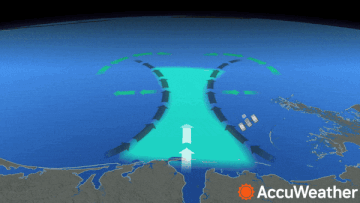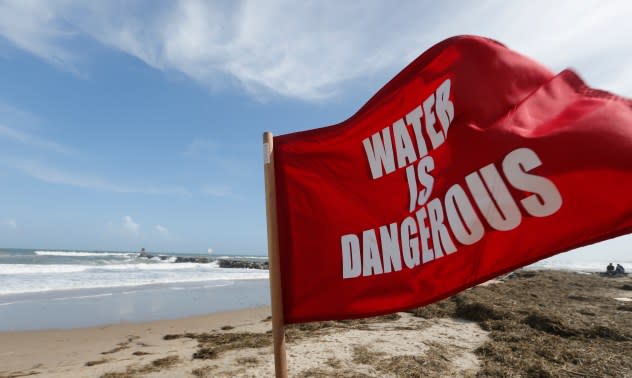Fifth tourist in four days dies at Florida beach said to be deadliest for rip currents in US
A fifth beachgoer has drowned in just four days during sweltering heat at a popular vacation spot in Florida. A 29-year-old man died Sunday in a rip current at Panama City Beach. Further details on either weren't immediately available.
Sixty-year-old Debbie Szymanski, on vacation from St. Louis, Missouri, was also killed Sunday in a deadly rip current at Hollywood Beach.
Her death comes after three men on vacation from Alabama were swept to their deaths within minutes of entering the water at Panama City Beach on Friday despite a single red flag warning of the danger. Harold Denzel Hunter, 25, Jemonda Ray, 24, and Marius Richardson, 24, went for a quick swim after they checked into their rental on the beach, according to the sheriff's office.
"The acts of courage by first responders were amazing," Bay County Sheriff Tommy Ford said in a statement. "Many of our rescue swimmers with the Sheriff's Office, Bay County Emergency Services and Panama City Beach went into the dark and dangerous waters for over two hours to attempt to rescue and search for the young men."
The men were pulled from the water, but all three died at local hospitals.
The first of the five recent victims at Panama City Beach, 19-year-old Ryker Milton, died last Thursday evening when he went out for a swim and got caught in a current, local ABC affiliate station KOCO News reported.
Also last Thursday, a couple fromâ Pennsylvania died in a rip current on Florida's East Coast while on vacation with their six children, bringing the total number of rip current deaths in Florida this week to eight. Brian Warter, 51 and Erica Wishart, 48, drowned in front of their six children when they were caught in a riptide north of West Palm Beach.
Local officials are warning people to stay out of the gulf waters if red flags are posted.
"PLEASE STAY OUT OF THE WATER," Ford posted on Facebook Sunday. "The water can appear calm, but underneath currents are treacherous today. It's just too dangerous right now to swim."
The five victims in Panama City Beach were all swimming when red flags were posted on beaches.
Double red flags indicate "extremely dangerous conditions" and no one should be swimming. Single red flags indicated "high hazard conditions with high surf and/or currents."
AccuWeather senior meteorologist Dave Houk said low tide cycles and high astronomical tides are two instances when rip currents can be the strongest. "The low tide part in a high astronomically tide cycle is a prime time for rip current risks to be dangerous," he explaind. "It's not the only time, but when all the common factors line up and these two factors are in place, the likelihood of strong rip currents is higher."
 |
Rip currents account for nearly 80% of all lifeguard rescues, according to the United States Lifesaving Association. Rip currents are channels of water that can pull swimmers away from shore and farther out into the ocean. More than 100 people a year are killed by rip currents, according to the United States Lifesaving Association.
The currents can be extremely narrow, between 10 and 20 feet wide, but larger rip currents can be more than 10 times that width, according to the National Weather Service (NWS). They can also pull people out to sea at speeds higher than 5 miles per hour, which is faster than Olympic swimmers.
Rip currents can occur at any time of the year, even on sunny days, where the hazards that stir up rip currents are well offshore. Beachgoers should pay attention to posted beach flags, which will warn of ocean hazards year-round.
 |
A warning flag flies from a lifeguard's vehicle as he patrols the beach during a break in the rain and wind storms in Virginia Beach, Virginia, on Saturday, Sept. 3, 2015. (AP Photo/Steve Helber) |
If trapped in the grip of a powerful rip current, swimmers should not panic and try to swim back toward shore. The force of a rip current can exhaust even the best swimmers. It is best to swim parallel to shore until free of a rip current's influence.
"You cannot fight that volume of water going out," Kottlowski said. "It's impossible. People who get caught panic, but it is best to stay calm and let the water calm down, and you'll be fine."
After swimming parallel to the coast for about 50 to 100 yards, a trapped swimmer should begin swimming on an angle, away from the rip current and toward the shore.
If swimming parallel to the shore does not work, The United States Lifesaving Association recommends calmly treading water and waiting out the current until it's possible to swim safely back to shore.
If it's impossible to reach the shoreline, a trapped swimmer should draw as much attention as possible to alert a lifeguard or onlooker who can get assistance.
Kottlowski also stressed the importance of being aware of potential dangers by checking NOAA forecasts for any warnings and alerts as well as with local officials before venturing into the surf.
"You should never go in by yourself," he said. "Each beach is different."




